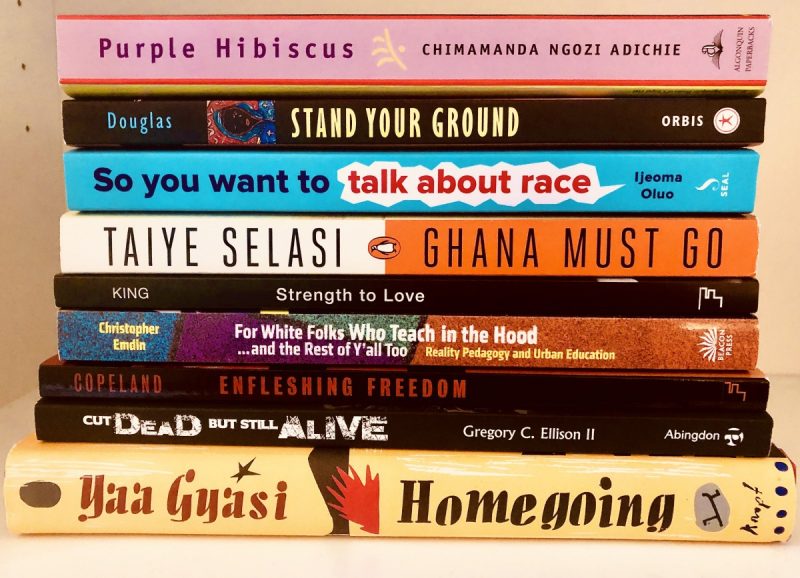by Mary Elder
“How do we hold people accountable for wrongdoing and yet at the same time remain in touch with their humanity enough to believe in their capacity to be transformed?” ~ bell hooks[1]
As we another election cycle comes to a close, as people respond to the hatred and hurt felt and grapple with what relationships look like in the face of such division, this quote has been recirculating:
And it points to deep truth—that oppressed people cannot justly be asked to be in relationship to oppressors, and to former oppressors. That the wounded cannot be responsible for the healing of the wounder. That relationship demands active work for justice.[2] That there are traumas too great for relationship to ever be safe.
And yet: for many people, these relationships are not a matter of choice—there are material realities and personal responsibilities. Those we disagree with are family members and employers, they are neighbors and they are world leaders. Whether we choose it or not, our lives and beings, our health and joy, the very existence of the earth we live on are interdependent. The ways we relate to one another, to political and economic systems, to movements for transformation, and to the earth cannot cease to impact the lives of another.

The questions and pain remain: how do we live in a world knowing we are interconnected to people we do harm to and those who harm us, with an ecosystem destroyed by capitalism? How do we coexist when one person’s liberation is another’s nightmare?
As Boyung Lee observes, even at humanity’s best, even as communities facing tragedy and violence offer liberation and hope, people always miss stories, experiences, and realities that are outside our own.[3] Some people have been enabled to live life with more blind spots and violent practices than others, and the work necessary for transformation depends on our places in the ecosystem. Yet we need each other to be human and to embody divine Goodness.
And so we must begin to wonder.[4] Scientists have observed how imagination is linked to our capacity for empathy, to improved group relationships and prosocial behavior.[5] Activist Valarie Kaur remarks that for white people, the desire itself to “not be racist” to black folks in fact leads to racism, whereas a desire to wonder, to be curious, and to imagine about their lives invites empathy and relationship.[6] Kaur also writes that while she does not owe oppressors affection or empathy, a choice to simply listen and wonder is one she offers herself as “a chance to live in this world without the burden of hate”.[7] For all of us, in different ways, imagination can be transforming, relational, and healing.
The Christian tradition offers us an abundance of examples of wonder and imagination. At least weekly, our worship turns to scriptures and ask what they mean for us today, imagining them onto our lives in diverse (sometimes competing) ways. We read glorious myths of creation and poetry and plays created by people wondering about who God was and who they were in relationship to God. We reenact Mary’s walk to Bethlehem and Jesus’ entry into Jerusalem yearly. Yet we also are asked to treat each other’s stories as sacred, to see Jesus in others, to listen and share and love. While what we can ultimately know about another person’s reality at times feels as distant as our ancient texts, in each we are invited into imagination and wonder, to seeing our interconnection and opening ourselves to change.
A practice from Ignatian Spirituality, which Harry Potter and the Sacred Text podcasters dub “sacred imagination”, takes a text (traditionally scripture), and invites listeners and readers to imagine themselves into it.[8] You can take the position of any living being in the text—it doesn’t need to be a main person, a named person, or even a person! But the point is to really picture yourself in the scene, feel the air, smells, tastes, sounds, emotions that could be occurring, and be open to new interpretations and meanings as you experience the text for yourself through your imagination. Hopefully, you find yourself wondering at the experience, creating backstories, meditating on the senses. But importantly, this practice offers a chance to encounter the unknown and unfamiliar in a story and to wonder at it, while and potentially exposing truths about ourselves and who we are. (For example, if you are a person who holds privilege in a social system, I would invite you NOT to shy away from it as you imagine, and to be open to learning something new about yourself and what it means to occupy positions of power.)
So, I invite you to listen to the following recording from Genesis 25 and begin your own practice of Sacred Imagination.
[1] Melvin McLeod, “‘There’s No Place to Go But Up’: Bell Hooks and Maya Angelou in Conversation,” Lion’s Roar, January 1, 1998, https://www.lionsroar.com/theres-no-place-to-go-but-up/.
[2] Jennifer Harvey and Traci D. Blackmon, Dear White Christians: For Those Still Longing for Racial Reconciliation (Grand Rapids, UNITED STATES: William B. Eerdmans Publishing Company, 2020), 68, http://ebookcentral.proquest.com/lib/emory/detail.action?docID=6260723.
[3] Boyung Lee, “Toward Liberating Interdependence: Exploring an Intercultural Pedagogy,” Religious Education 105, no. 3 (May 19, 2010): 283–98, https://doi.org/10.1080/00344081003772055.
[4] Rachel Carson, “Help Your Child to Wonder,” Women’s Home Compansion, July 1956.
[5] Brendan Gaesser, “Constructing Memory, Imagination, and Empathy: A Cognitive Neuroscience Perspective,” Frontiers in Psychology 3 (January 9, 2013), https://doi.org/10.3389/fpsyg.2012.00576.
[6] Valarie Kaur, “Revolutionary Love: Seeing No Stranger.”
[7] Valarie Kaur, See No Stranger: A Memoir and Manifesto of Revolutionary Love (Random House Publishing Group, 2020), 139.
[8] “Spiritual Practice Resources,” Harry Potter and the Sacred Text, accessed November 14, 2020, https://www.harrypottersacredtext.com/spiritual-practice-resources.



1 Comment
Add Yours →Oof, secondary wives! But if I am honest with myself about privilege, I have to see those other women and imagine myself as Sarah. Mary, you might also be interested in reading Maxine Greene’s Releasing the Imagination, in which she, too, makes the argument that imagination is a bridge to empathy.